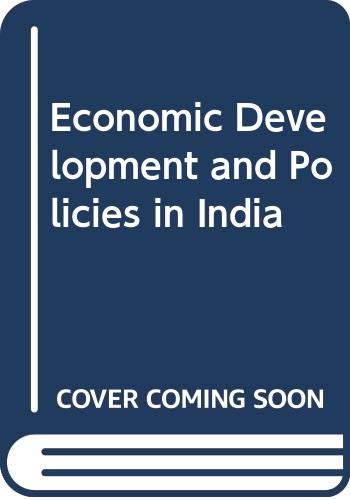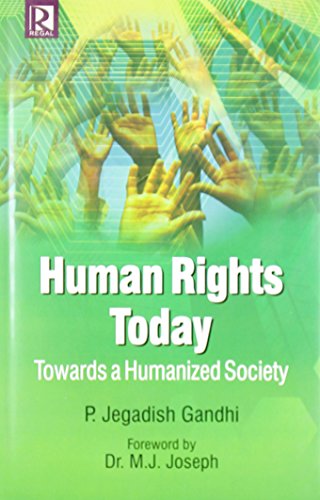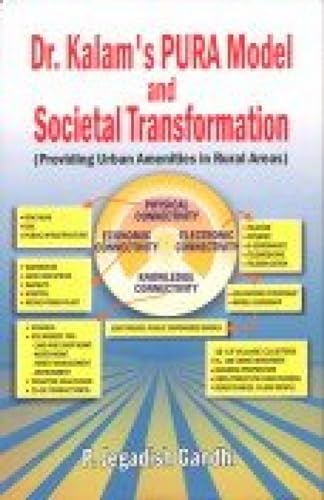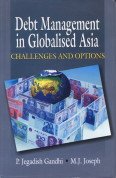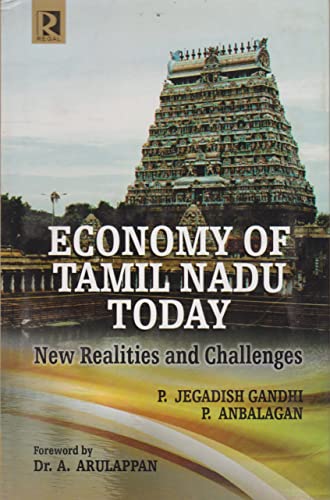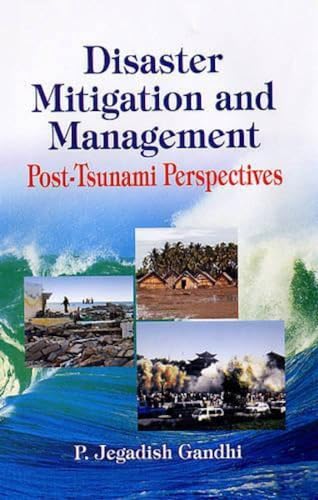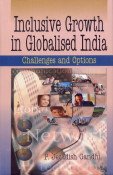Jegadish Gandhi (24 results)
Product Type
- All Product Types
- Books (24)
- Magazines & Periodicals
- Comics
- Sheet Music
- Art, Prints & Posters
- Photographs
- Maps
-
Manuscripts &
Paper Collectibles
Condition
Binding
Collectible Attributes
- First Edition (1)
- Signed
- Dust Jacket (7)
- Seller-Supplied Images
- Not Printed On Demand
Free Shipping
Seller Location
Seller Rating
-
Jesus Christ 24x7: An Introduction To Immanuelism
ISBN 10: 8184653794ISBN 13: 9788184653793
Seller: Books Puddle, New York, NY, U.S.A.
Book
Condition: New.
More buying choices from other sellers on AbeBooks
New offers from US$ 4.86
-
Economic Development and Policies in India
Published by Har-Anand Publications
ISBN 10: 8124102155ISBN 13: 9788124102152
Seller: Books Puddle, New York, NY, U.S.A.
Book
Condition: New. pp. 175 1st Edition.
More buying choices from other sellers on AbeBooks
New offers from US$ 6.95
-
Human Rights Today: Towards a Humanized Society
Published by Regal Publications, New Delhi, 2014
ISBN 10: 8184843909ISBN 13: 9788184843903
Seller: Books in my Basket, New Delhi, India
Book
Soft cover. Condition: New. ISBN: 9788184843903, 182pp.
-
Indian Transport System
Published by Mittal Publication, New Delhi, 1994
ISBN 10: 8170995566ISBN 13: 9788170995562
Seller: Books in my Basket, New Delhi, India
Book
N.A. Condition: New. ISBN:8170995566.
-
Human Rights Today
Published by Regal Publications, New Delhi, 2014
ISBN 10: 8184843577ISBN 13: 9788184843576
Seller: Books in my Basket, New Delhi, India
Book
N.A. Condition: New. ISBN: 9788184843576, 182pp.
More buying choices from other sellers on AbeBooks
New offers from US$ 11.54
Used offers from US$ 48.91
Also find Hardcover
-
National and Sub-National Economic Development : Post Economic Reforms
Published by Deep and Deep, 2003
ISBN 10: 817629442XISBN 13: 9788176294423
Seller: Vedams eBooks (P) Ltd, New Delhi, India
Book
Hardbound. Condition: As New. Contents: Foreword. Preface. I. National macro economic dynamics: India: 1.A decade of reforms: where to now?/P.R. Brahmananda. 2. Regulation of tariffs in the power sector/C. Rangarajan. 3. Future of banking and insurance/R. Parthasarathy. 4. Price transmission between global and Indian prices in agricultural commodities market/P. Ganesan. 5. A plan with a difference/K. Venkatasubramanian. 6. "India vision 2020"-is it Utopian or Cornucopian/P. Jegadish Gandhi. II. Sub-national economic dialects: Tamil Nadu: I. Overview dimensions: 7. Political economy of Tamil Nadu/G. Viswanathan. 8. Tamil Nadu economy: progress during nineties and challenges ahead/K.V. Palanidurai. 9. Growth performance of Tamil Nadu:interfacing with Adhra Pradesh/Biman Chandra De. 10. The economy of Tamil Nadu: marching ahead/Ram Naresh Thakur. 11. Growth and development: a comparative study of Tamil Nadu and India/R. Arunachalam and K. Nandha Kumar. 12. Performance of public sector undertakings in Tamil Nadu/Gautam Naresh and J.V.M. Sarma. II. Primary sector prism: 13. Utilisation of irrigation for sustainable agricultural development in Tamil Nadu/D. Rudrappan. 14. Increasing population and decreasing agricultural land in Tamil Nadu/T. Govindaraj and R. Rajendran. 15. Effect of education in the adoption of agricultural technologies in Tamil Nadu: a micro-level analysis/J. Govindadass. 16. Development prospects of fisheries sector in Tamil Nadu/K. Pazhani. III. Services sector signals: 17. Reforms in power sector: an analysis/K.T. Rengamani and P. Ganesan. 18. Pricing of bus 400 pp.
-
Dr Abdul Kalams Futuristic India (reprint)
Published by Deep and Deep, 2018
ISBN 10: 8176298395ISBN 13: 9788176298391
Seller: Vedams eBooks (P) Ltd, New Delhi, India
Book
Hardcover. Condition: As New. Contents Preface. Prescript. I. Development Dynamics 1. A.P.J. Abdul Kalam a socio economic thinker. 2. India 2020 vision. 3. Developed India model. 4. Knowledge driven societal transformation. 5. PURA a people's movement. 6. PURA model an academic angle. 7. Energy vision quality electricity for all. 8. Public private partnership perspectives. II. Social Dialogues 9. Dynamics of creative leadership. 10. New work culture perspectives. 11. Elimination of corruption. 12. Towards social amity. 13. Dr. Kalam's script empowering rural India. Postscript a memorable meeting with the president of India. Book review reflections. Mediascan. Bibliography. Index. The vibrant visionary thoughts with viable mission modes of President A.P.J. Abdul Kalam have now become a phenomenon in Indian public life. His autobiography wings of fire has impacted almost every Indian thought. His interactions with young people have ignited their minds to unlease their latent potent power so as to widen their positive nation building activities. Dr. Kalam envisions an empowered and developed India by 2020 through competitive and innovative technology driven societal transformation. He also charted various state government development mission mode models based on their core competencies. Dr. Kalam has a simplicity and humility which instantly endears him to all who come into contact with him. His social dialogues break conventional barriers and build bridges of new human relations in a pluralistic society. It is unheard in the history of post independent India that a President of India is so committed to spearhead a social revolution as Dr. Kalam. Dr. Kalam's vision has a number of ideas which are similar to those of the new Institutional School Neo classical School with their emphasis on the primacy of markets and the concept of embodied technology and its role in development and the importance of innovations and entrepreneurs in development as stressed by the Austrian economist J.A. Schumpeter Dr. Kalam's social thoughts are soiled with deep native roots as his economic thoughts are manifested from salient indigenous branches. Dr. Kalam's socio economic ideas India 2020 vision Developed India Knowledge driven Societal Transformation PURA Quality Electricity for all Public Private Partnership Perspectives Creative Leadership New Work Culture Elimination of Corruption and Social Amity are interpreted in simple language with illustrations and model intelligible to all readers. A world list of Dr. Kalam's pet words and phrases and their related themes is added for the better understanding of Kalamism. 166 pp.
-
Dr Kalams PURA Model and Societal Transformation (Reprint)
Published by Deep and Deep, 2018
ISBN 10: 8176296643ISBN 13: 9788176296649
Seller: Vedams eBooks (P) Ltd, New Delhi, India
Book
Hardcover. Condition: As New. Dust Jacket Included. Contents Preface. Introduction. I. Pre PURA stage socio economic divides 1. Dynamics of societal transformation/P. Jegadish Gandhi. 2. Rural urban divide Vision vignettes/S.P. Gupta. II. The PURA revolution creating connectivities 3. PURA a road map for New Rural India/A.P.J. Abdul Kalam. 4. PURA challenges and opportunities/P.V. Indiresan. 5. PURA a neo Gandhian approach to development/Ruddar Datt. 6. PURA towards a sustainable society/K. Venkatasubramanian. 7. PURA an academic angle/P. Jegadish Gandhi. III. Post PURA scenario transforming rural realities 8. Connecting rural India village resource centres/M.S. Swaminathan. 9. The virtual village some case studies/S.S. Jeevan. 10. PURA a success story/Anand Parthasarathy. Bibliography. Index. Ever since Dr. A.P.J. Abdul Kalam has become President of India (July 25 2002) he has spearheaded a socio economic movement of igniting the young minds with positive thoughts and of propagating the Developed India by 2020 vision with constructive mission modes. PURA (Providing Urban Amenities in Rural Areas) is the major component of President's Dream for developed India. It differs from the conventional ideas of economic development of rural areas in many ways a comprehensive and composite rural development government investment at urban levels in rural programmes reverse rural urban migration the prerequisite quality infrastructure supportive modern industry and investment in social and commercial service and private enterprise initiative. PURA habitat design depends upon the infrastructural ring road linking a loop of villages and the interfacing of four connectivities physical electronic knowledge and economic to enhance rural prosperity. The model should enable proper selection of village clusters and deployment of the youth in different areas of rural development to make this programme a reality. This book is very informative and interpretative in its illuminating contents on PURA scheme. A valuable referral to students teachers and research scholars in social sciences and technocrats innovative entrepreneurs and non governmental programmers and social activists in rural transformation. 118 pp.
-
Debt Management in Globalised Asia : Challenges and Options
Published by Deep and Deep, 2006
ISBN 10: 8176297534ISBN 13: 9788176297530
Seller: Vedams eBooks (P) Ltd, New Delhi, India
Book
Hardcover. Condition: As New. Contents: Preface. Introduction. I. Dynamics of the new global economic order: 1. The economic trinity--IMF-WB-WTO: its operational dynamics/Mammen Varkey. 2. Emerging geo-politico economic trends in Asia/Mathews George Chunakara. 3. Debt trap in globalised Asia today: a study of methodology of research in Asian economics/Vedagiri Shanmugasundaram. 4. Globalisation and debt crisis in Asian countries/A.R. Veeramani. 5. Ethos of multinational companies/Saju Kurien. II. Country reports: 6. Public debt management in India: theoretical and empirical approaches/T. Lakshmanasamy and R. Arunachalam. 7. An economic analysis of external debt in India: before and after nineties/S. Iyyampillai and P. Balamurugan. 8. External debt management and social sector in India/K.C. John and Subhashini Muthukrishnan. 9. Sri Lanka's debt problem: an appraisal/Marshal Fernando. 10. Debt trap: the Philippine scenario/Priscilla R. Atuel. 11. China's financial reforms: a bird's eye view/A. Ranga Reddy. III. Human dimensions of debt: 12. Wealth and its spiritual dimensions/M.J. Joseph. 13. Debt: a theological perspective/M. Mani Chacko. IV. Debt relief perspectives: 14. Debt-free Asia: vision 2020/P. Jegadish Gandhi. 15. Debt crisis resolution in Asia: a futuristic outlook/V. Mathew Kurian. Appendices: 1. A statement of the Asian level seminar. 2. Additional readings. Index. "Debt bondage has become a borderless problematic phenomenon through the ages. Over the past 25 years (1980-2005), the magnitude of debt crisis has worsened in most of the Asian countries. The various palliative prescriptions of economic trinity--IMF, WB and WTO--to overcome "debt overhang" has actually fallen short of expectations with side-effects demoralizing the basic politico-economic structures and social value systems in developing countries. The Jubilee 2000 coalition debt cancellation across the countries have intensively impacted the wisdom of "the Washington Consensus" messiahs including G-8 big brothers of world economic salvation. Against the emerging unipolar world, enveloping globalisation and enlarging debt tentacles, there is greater urgency to interface with the Asian level and global links of the debt dynamics today. This compilation contains the concept paper, keynote address, seminar papers and documents of an Asian level seminar on debt trap in the globalised Asia today held at Ecumenical Christian Centre, Bangalore on January 27-29, 2006. The deliberations of the seminar singled out that only by building up the capabilities of people that debt crisis in Asia could be sustainably solved through the people-centric development programmatics and signalled an appeal to the donor agencies to "forgive" debts in the larger interest ushering in a new socio-economic order in Asia. The book is divided into four parts. While Part I focuses on the new global economic order, Part II presents country reports on India, China, the Philippines and Sri Lanka, Part III touches on the human dimensions of debt bondage and relief. Part IV deals with the debt relief perspectives pertaining to debt crisis resolution in Asia and Debt-Free Asia vision 2020. A statement issued by the participants of the Seminar and additional reading materials are also included for a wider discussion. How do we make sure that will debt relief raise growth substantially? Will debt relief benefits poor people? And how can we ensure that poor countries in Asia do not get into debt trap again? These are some of the key policy issues and programmes covered in this extremely useful book." (jacket).
-
Public Private Partnership in Nation Building
Published by Deep and Deep, 2005
ISBN 10: 8176297569ISBN 13: 9788176297561
Seller: Vedams eBooks (P) Ltd, New Delhi, India
Book
Hardcover. Condition: As New. Dust Jacket Included. Contents Preface. Introduction. I. Public Private Partnership periscopic perspectives 1. Public Private Partnership (PPP) in perspective/C.T. Kurien. 2. Value perspectives in nation building/M.J. Joseph. 3. Economic reforms and development reflections on economic paradigms and Public Private Partnership/R. Arunachalam and T. Lakshmanasamy. 4. Public Private Partnership perspectives of A.P.J. Abdul Kalam/P. Jegadish Gandhi. 5. State and the civil society dynamics towards and sustainable synergy/S.N. Sangita. II. Sectoral partnerships focal prospects 6. Public Private Partnership in social sectors a participatory model/V. Mathew Kurian. 7. Education sector opportunity for all or a few/V. Loganathan. 8. Health sector equity care for all/A. Arulappan. 9. Telecommunications sector wider connectivity/V. Mohanasundaram. 10. Agricultural sustainability resource constraints/K.C. John. 11. Public Private Partnership and post harvest technology a rich field/S. Iyyampillai and P. Balamurugan. 12. Private Participation in Public Delivery System a case study of metro water supply/G. Narasimha Raghavan. Appendices 1. A statement of the National Seminar. 2. Tenth Plan (2002 2007) and PPP perspectives. 3. PPPs in India. Index. Nation building is a complex dynamics of ideological philosophical political socio economical and cultural impactional forces. Since independence the simultaneous role of public and private sectors in nation building activities was widely acclaimed as an effective socio economic management policy in India. The economic reforms strategy of growth adopted in the 1990s has not benefited large segments of the population. It is acknowledged that the government spending on the social sector (comprising education health and family welfare water supply sanitation housing social welfare nutrition rural employment and minimum basic services) in percentage terms has been stagnant since 1996 97 in India. Market failures and the market socialism successes have mandated neo participatory role for the public and private sectors in well being of the people. In the beginning of 21 century PPP has become not merely a nation building programme but a redefined strategy of societal governance. It is based on a fundamental philosophy of government and of government's role in relation to the other essential institutions of a free and healthy society. This compilation contains the concept paper keynote address seminar papers documents and response papers of the National Seminar on Public Private Partnership (PPP) in Nation Building held at Ecumenical Christian Centre Bangalore on January 28 30 2005. The book is an important contribution to the Indian new public management philosophy debate and dialogue dynamics. The contents are guiding referral to students scholars in social theories and policy pundits partnership seekers development programmers and social activists in nation building activities. 216 pp.
-
Economy of Tamil Nadu: New Realities and Challenges
Published by Regal Publications, New Delhi, 2016
ISBN 10: 8184845723ISBN 13: 9788184845723
Seller: Books in my Basket, New Delhi, India
Book
N.A. Condition: New. ISBN: 9788184845723, 368pp.
-
Disaster Mitigation and Management : Post Tsunami Perspectives (reprint)
Published by Deep and Deep, 2020
ISBN 10: 8176299758ISBN 13: 9788176299756
Seller: Vedams eBooks (P) Ltd, New Delhi, India
Book
Hardcover. Condition: As New. Dust Jacket Included. Contents Foreword. Preface. Acknowledgements. Introduction. I. Disaster dynamics an overview 1. Need for early warning system/A.P.J. Abdul Kalam. 2. The Anatomy of a disaster/V. Jayanath. 3. Tsunamis of tomorrow/U.K. Sen. 4. Triggering disasters/S.S. Jeevan. II. Post Tsunami scenario diagnostic studies 5. Tsunami in India some revelations/S. Iyyampillai and P. Balamurugan. 6. Isolation of Car Nicobar/Subrata Nagchoudhury. III. Socio economic dimensions focal issues 7. Socio economic reconstruction of the natural calamities/P. Jegadish Gandhi. 8. Socio economic impact of disaster relief operations/Vivek Kumar Porwal. 9. Eco economic losses of the Asian calamity/A. Ranga Reddy. IV. Relief and rehabilitation proactive role of NGOs 10. Neglecting core issues and rehabilitation/Krishnamurthy. 11. Need for multidisciplinary approach/Jacob Dharmaraj. 12. Need for an institutional approach/V. Mohanasundaram. 13. Need for environmental resource centre the DMERC model/Dipankar Das Gupta. 14. NGO's relief and rehabilitation a case of CASA/Emerson Samuel. 15. Proactive role of world vision of India/Christina Nisha. 16. Livelihood restoration development promotion group experiences/R. Bhakther Solomon. V. Psycho social domain impactional interventions 17. Psycho social intervention in disaster management/George Padiakkara. 18. Problems of the peripheral people/Raju Samuel. 19. Focus on change management/R. Christopher Rajkumar. 20. Trauma counselling in Afghanistan and Pakistan/Sarah Crawford Browne. 21. Interfaith action challenges issues and prospects/John Kumar. 22. Spiritual dimensions of disaster management/M.J. Joseph. VI. Disaster preparedness policy and programmes 23. The national disaster management/Shivaraj Patil. 24. Tsunami and a secure future/John Kurian. 25. Disaster management the 10 Plan (2002 2007) perspective. 26. The disaster management Act 2005 salient features. Appendix Facts file tsunami earthquakes floods and Heavy rains. Index. Since 26 December 2004 the occurrence of natural calamites in terms of Tsunami and heavy floods has become a regular phenomenon in India. Not only did they affect the people in coastal areas but also inhabitants in and around inland regions. During the past one year it is evident that the extent to which a population is affected by a calamity does not purely lie in the physical component of vulnerability but is contextual also to the prevailing social and economic conditions and its is consequential effect on human activities within a given society. Amid the countless corpse statistics countable survivors stories and gigantic relief and rehabilitation operations many eyebrows have raised about the philosophical question is there God. It is reflected in a spate of articles and letters in newspapers published by rationalists religious leaders and theologians faith believers scientists and common people all over the world. Post Tsunami rescue relief and rehabilitation experiences by different governments NGOs and donor agencies have opened up new vistas in disaster mitigation and management strategies. This special book Disaster Mitigation and Management Post Tsunami Perspectives is to commemorate the decadal service (1996 2006) of Vellore Institute of Development Studies (VIDS). Additional informative as well as illustrative media reports especially after two year historic natural disaster have been added to build up the necessary practical parameters of disaster mitigation and management among the people. Do's and don'ts related to Tsunami earthquake floods and heavy rains are catalogued as cautious preventive measures. The book's coverage and contents on disaster management will become a good referral for post Tsunami disaster plans and programmes. 250 pp.
-
India and China in the Asian Century : Global Economic Power Dynamics (Reprint)
Published by Deep and Deep, 2019
ISBN 10: 8176299855ISBN 13: 9788176299855
Seller: Vedams eBooks (P) Ltd, New Delhi, India
Book
Hardcover. Condition: As New. Dust Jacket Included. Contents Preface. Acknowledgements. List of contributors. Introduction. I. Dialects and dynamics of the Asian Century 1. The Asian century/Ashish Gupta. 2. A place for India in Asian century/A. Vasudevan. 3. Towards the Indian century some reflections/Sumit K. Majumdar. 4. World economy made in China/Alok Ray. 5. India and China towards a cooperative partnerships/C.V. Ranganathan. 6. India and China on a global move/Batuk Gathani. 7. Super economic power dynamics of India and China/P. Jegadish Gandhi. 8. Knowledge and the Asian challenge/C.P. Chandrasekhar and Jayati Ghosh. 9. The Asian Giants and Latin America/Jorge Heine. 10. Dimensions of decent work in Asia/Juan Somavia. II. China the Dragon's development dimensions 11. China towards Marxian democratic model/A. Ranga Reddy. 12. Macro economic policy in China's economic growth/Jayati Ghosh. 13. In China a problem of plenty/Pallavi Aiyar. 14. Protecting intellectual property the Guanxi way/G. Narasimha Raghavan. 15. Disinvestments The Chinese example/S. Venkitaramanan. 16. Rising inequality in China/C.P. Chandrasekhar and Jayati Ghosh. 17. Winds of change in China's growth strategy/S. Sethuraman. 18. Lessons from China/K. Subramaniam. III. India the Tiger's development strides 19. India has come of age/Ashok Jacob. 20. India the land of people's power/Ajai Chowdhry. 21. Need for the agriculture renewal/M.S. Swaminathan. 22. On growth poverty and opportunity/G. Srinivasan. 23. FDI will India edge out China/S. Majumder. 24. China's lessons for India/Dan Steinbock. IV. The Asian Giants global economic power dynamics 25. India and China through fresh eyes/Qiu Yonhui. 26. A comparative study of growth pattern in India and China a review/Md. Abdus Salam. 27. The China India Matrix/Rasheeda Bhagat. 28. Growth sustainability of China and India/Andy Xie. 29. Agricultural development and poverty alleviation in China and India a comparative analysis/M.S. Kallur. 30. Mobile industry in India and China a Must Win market/Dan Steinbock. 31. India China trade a long road ahead/Pallavi Aiyar. 32. Can India and China emerge as superpowers/S. Iyyampillai and P. Balamurugan. 33. India and China a win win game/Ashish Gupta. 34. India China economic ties develop a different paradigm/Ramgopal Agarwal. 35. China and India the Asian drivers/R. Seshasayee. Appendices. Index. The globalised economic changes is India and China have now become a global talk. The soothsayers all over the world have visualized a new Asian socio economic order with the constellation of the Tiger Dragon cluster in influencing the course and contours of the human life in the 21 century. The key question is whether India and China will be partners or rivals. If partners how best to go beyond bilateral issues and ensure international peace security and stability. If rivals how best to resolve areas of conflict and competition and drive the engine of growth through the irreversible cooperative partnership. This Vellore Institute of Development Studies (VIDS) commemorative (1996 2006) compendium India and China in the Asian Century Global Economic Power Dynamics is drawn from well researched commentary papers and documents by 36 prominent journalists eminent diplomats academicians scholars and leading trade and commerce strategists. The contents and coverage span from understanding the present position of modern Asian Drama dynamics delineating their inherent problems and new opportunities to carve out a strategic India China global partnership. The book is divided into four broad areas of discursive debates dialects and dynamics of the Asian Century China the Dragon's development dimensions India the Tigers development strides and The Asian Giants global economic power dynamics. Appendices are full of macro socio economic statistics of India and China in the context of world economy. The salient features of the recently issued joint declaration by the Indian Prime Minister Manmohan Singh and the Chinese President Hu Jintao on N.
More buying choices from other sellers on AbeBooks
Used offers from US$ 20.00
-
Inclusive Growth in Globalised India : Challenges and Options (reprint)
Published by Deep and Deep, 2018
ISBN 10: 8184500572ISBN 13: 9788184500578
Seller: Vedams eBooks (P) Ltd, New Delhi, India
Book
Hardcover. Condition: As New. Dust Jacket Included. Contents Preface. Acknowledgements. Contributors. Introduction. I. Dynamics of economic globalisation 1. India a developed nation before 2020/A.P.J. Abdul Kalam. 2. Promise of globalisation/Joseph E. Stiglitz. 3. Why globalisation is in trouble/Branco Milanovic. 4. Towards an inclusive globalisation/Manmohan Singh. 5. India in a globalising world/Montek S. Ahluwalia. 6. Globalised Indian economy structural changes and challenges/M.R. Aggarwal. 7. Impact of globalisation on Indian agriculture/A. Ranga Reddy and M. Sampath Kumar Raju. 8. Inclusive Globalisation and food Security/I. John Mohan Razu. 9. Financial globalisation/T.B. Kapali. II. Dimensions of inclusive growth 10. Approaching the Eleventh Plan/C.P. Chandrasekhar and Jayati Ghosh. 11. Inclusive growth an innovative approach/P.V. Indiresan. 12. Inclusive model of development/Aditya Puri. 13. Non Exclusion to Inclusive Growth Strategy plan perspectives/P. Jegadish Gandhi. 14. Will the aim of inclusive growth be achieved/M.Y. Khan. 15. Strategising Inclusive growth/T.S. Papola. 16. Financial inclusion/V. Jagan Mohan. 17. Need for financial Deepening /C.J. Punnathara. 18. The Eleventh Plan and Human Resource Development/Bhanoji Rao. III. Issues in inclusive growth 19. Can GDP growth do everything/S. Iyyampillai. 20. Inclusive growth is it achievable/V. Mohanasundaram. 21. Inclusiveness and inequality/Ranabir Ray Choudhury. 22. Regional disparities need for social inclusion/C.J. Punnathara. 23. In pursuit of excellence and inclusion in education/P.V. Indiresan. 24. Move towards an inclusive Child Health Care System/Sherly Kurien. 25. Is inclusive growth exclusive of environment/G. Narasimha Raghavan. 26. Inclusive need for interlinking of rivers/R. Christopher Rajkumar. 27. Inclusive growth in the globalised India a critique/G.M. Bhat and Shabir Ahmad Padder. Appendix. Index. Ever Since the Planning Commission (June 14 2006) styled its Approach Paper to the Eleventh Five Year Plan (2007 2012) with a caption Towards Faster and More Inclusive Growth the phrase Inclusive Growth has assumed greater significance in plan paradigm shift discussions at different levels all over the country and abroad. Inclusive growth is a welcome shift in emphasis in Plan Approach Paper but will it mean better distribution in the globalised India. The book is divided into three parts. Part I analyses the dynamics of globalisation in the world as well as in Indian settings. While Part II focuses on the various dimensions of inclusive growth Part III Identifies the issues involved in achieving inclusive growth against the embedded inequitable social system with workable solutions. The contents and coverage of the topical theme are comprehensive and critical in its scope spread and solutions. A valuable volume to academics research scholars and students in development and planning studies and also to policy makers. 284 pp.
More buying choices from other sellers on AbeBooks
New offers from US$ 59.05
Used offers from US$ 25.00
Also find Hardcover
-
Nobel Laureate Franco Modigliani and His Theory of Saving. Foreword, P. R. Brahmananda.
Published by Vellore: Institute for Social Sciences and Research, 1986., 1986
Seller: Ted Kottler, Bookseller, Redondo Beach, CA, U.S.A.
First Edition
Hardcover. Condition: Very Good. Dust Jacket Condition: Very Good. 1st Edition. 7 leaves, 92 pp. Original cloth. Very Good, in very good dust jacket.
-
Nobel laureate Franco Modigliani and his theory of saving Foreword Dr. P.R. Brahmananda.
Published by Vellore : Institute for Social Sciences and Research, 1986
Seller: BBB-Internetbuchantiquariat, Bremen, Germany
Book
Hardcover/Pappeinband. Condition: Sehr gut. 92 pages ; 21 cm Zustand: sehr gut; Original-Schutzumschlag; w17254 Wenn das Buch einen Schutzumschlag hat, ist das ausdrücklich erwähnt. Rechnung mit ausgewiesener Mwst. Sprache: Deutsch Gewicht in Gramm: 240.



